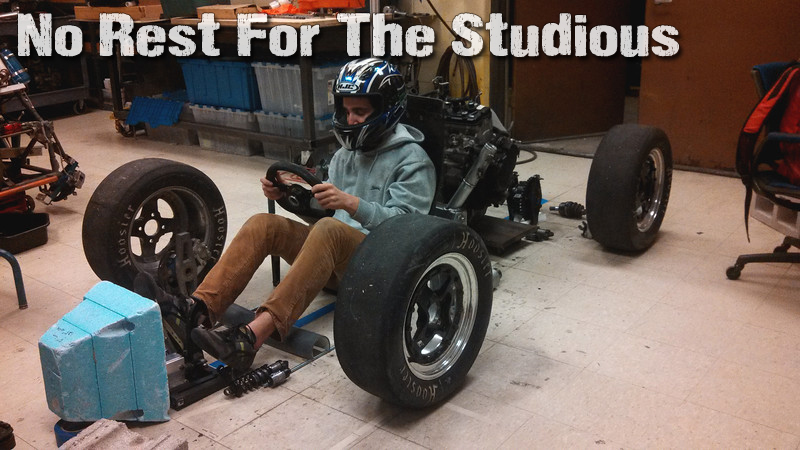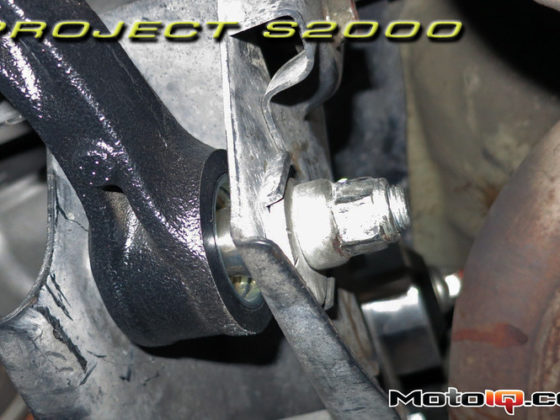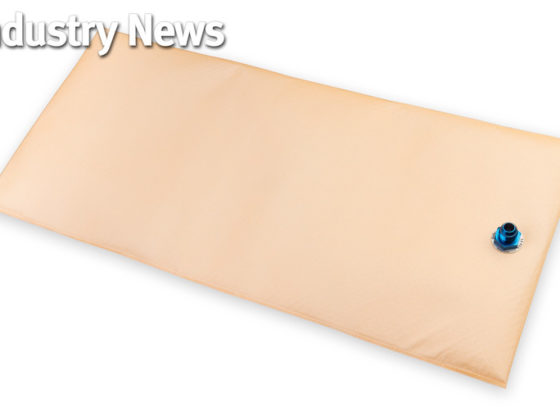,
Early on, we worked on designing a swept rear suspension. Hanging the diff out the back of the car and sweeping the control arms back to meet the axles would allow us to ditch the entire rear suspension box, saving a dozen or so pounds. Not only is it overall weight, but this would be polar weight, helping centralize mass. Also being at the rear, this would help even the weight distribution. This is fairly common for SAE cars. Eventually though, the swept suspension was shelved due to potential failure modes. Lots of teams do use this design with great success, but with less than a month before the suspension needed to be built, there were too many problems left to solve and a return to known territory was the only option.
 This is what the swept rear suspension would have looked like. It was eventually canned for a few reasons. The first was driveshaft angle. While not present here, the axles would have had to articulate by around 20 degrees, far more than the CV joints could ever hope to handle. To fix this, the arms were swept rearward to lower the angle as much as possible. Unfortunately, this began to cause issues with toe steer. With the arms angled backwards, the wheels would want to toe outward under acceleration, not good at all! Finally, the diff was mounted with a pair of pillow block bearings. These pillow blocks were causing stress risers on their respective mounting tubes and could fail under hard launch. With time running short, the whole idea was scrapped and a suspension box was added to give the control arms and diff a solid mounting structure. While many teams are able to make this design work, there were simply too many problems to solve in too short a time. Low weight is great unless it causes component failures! With the difficulties better understood, perhaps UD can pursue this idea again in the future.
This is what the swept rear suspension would have looked like. It was eventually canned for a few reasons. The first was driveshaft angle. While not present here, the axles would have had to articulate by around 20 degrees, far more than the CV joints could ever hope to handle. To fix this, the arms were swept rearward to lower the angle as much as possible. Unfortunately, this began to cause issues with toe steer. With the arms angled backwards, the wheels would want to toe outward under acceleration, not good at all! Finally, the diff was mounted with a pair of pillow block bearings. These pillow blocks were causing stress risers on their respective mounting tubes and could fail under hard launch. With time running short, the whole idea was scrapped and a suspension box was added to give the control arms and diff a solid mounting structure. While many teams are able to make this design work, there were simply too many problems to solve in too short a time. Low weight is great unless it causes component failures! With the difficulties better understood, perhaps UD can pursue this idea again in the future. When all was said and done, the chassis shrank by a foot in length, lost the same in height, and was skinnied up by 4 inches. Along with the reduced size, a number of excess tubes were removed from the structure and non-critical tubes were reduced in wall thickness. CAD claimed the new chassis would be 30 pounds lighter! Reality was closer to 20 pounds, but hey, not too shabby (weld beads were not factored in and neither were brackets). If we could continue to shave weight throughout the rest of the car like that, 100 pounds would be easy.
When all was said and done, the chassis shrank by a foot in length, lost the same in height, and was skinnied up by 4 inches. Along with the reduced size, a number of excess tubes were removed from the structure and non-critical tubes were reduced in wall thickness. CAD claimed the new chassis would be 30 pounds lighter! Reality was closer to 20 pounds, but hey, not too shabby (weld beads were not factored in and neither were brackets). If we could continue to shave weight throughout the rest of the car like that, 100 pounds would be easy. To separate the chassis, these lug joints were adopted. Four large bolts would hold the front and rear halves of the frame together, along with the sleeved roll bar supports. The inside of the rear tube is sleeved to prevent it from collapsing under the pressure of the bolt. This split is just behind the roll bar, exactly as requested. To further ensure the structure would be sound, the front engine mounts also bolt to the front half of the chassis. This design not only allows for a full split of the car, but also by leaving the lower joints attached, the car can be hinged in half allowing quick access to the front of the engine and the fuel system.
To separate the chassis, these lug joints were adopted. Four large bolts would hold the front and rear halves of the frame together, along with the sleeved roll bar supports. The inside of the rear tube is sleeved to prevent it from collapsing under the pressure of the bolt. This split is just behind the roll bar, exactly as requested. To further ensure the structure would be sound, the front engine mounts also bolt to the front half of the chassis. This design not only allows for a full split of the car, but also by leaving the lower joints attached, the car can be hinged in half allowing quick access to the front of the engine and the fuel system.
 For the suspension, we went with the tried and true unequal length control design front and rear. Shocks are pushrod activated. The rockers also activate the anti-roll bars, reducing unsprung weight. The arms are all steel tube with rod ends on the chassis and pressed in spherical bearings at the upright. The upright is a custom design made out of aluminum. One way we reduced weight was to change the control arm mounts from steel to aluminum. The clevises on the upright had been steel in previous years. With proper FEA analysis, it was determined that we could us aluminum and shave weight by 50%. This would only add up to a pound overall, but it was one of the few ways weight could come out of the suspension. The uprights and brakes are leftover from the 2012 car. Ideally, we would have redesigned or lightened the uprights we had, but once again time prohibited this. Designing uprights is a tricky task: get it wrong and you'll end up like Sebastian Buemi. Our upright design had served us faithfully for many years and while it is probably due for an update, there was other low hanging fruit to be had in this round of design. The pushrod in front mounts to the middle of the upright with the steering arm. Speaking of steering, a small amount of positive ackerman was designed in to aid in slow corners.
For the suspension, we went with the tried and true unequal length control design front and rear. Shocks are pushrod activated. The rockers also activate the anti-roll bars, reducing unsprung weight. The arms are all steel tube with rod ends on the chassis and pressed in spherical bearings at the upright. The upright is a custom design made out of aluminum. One way we reduced weight was to change the control arm mounts from steel to aluminum. The clevises on the upright had been steel in previous years. With proper FEA analysis, it was determined that we could us aluminum and shave weight by 50%. This would only add up to a pound overall, but it was one of the few ways weight could come out of the suspension. The uprights and brakes are leftover from the 2012 car. Ideally, we would have redesigned or lightened the uprights we had, but once again time prohibited this. Designing uprights is a tricky task: get it wrong and you'll end up like Sebastian Buemi. Our upright design had served us faithfully for many years and while it is probably due for an update, there was other low hanging fruit to be had in this round of design. The pushrod in front mounts to the middle of the upright with the steering arm. Speaking of steering, a small amount of positive ackerman was designed in to aid in slow corners.
 The rear suspension is nearly identical to the front, save for the lack of steering arms, and a different mounting point for the pushrod (in the front, the pushrod has to mount to the centerline of the upright. If it was offset, the spring would act on the steering under cornering, causing bumpsteer. In the rear, the pushrod must dodge the axle and since the rear uprights are fixed, torque steer is not an issue). The toe link mounts directly to the lower control arm, negating bump steer (since the toe link and lower arm are on the same plane). While some teams try to design their SAE cars with some form of oversteer (to better handle the very tight and technical tracks FSAE throws at students), we opted to design a neutral car. When selecting a roll center, we focused on keeping a roll center that was stable as opposed to one that gave a low roll couple. Since roll center moves as the body rolls, keeping a consistent roll couple was deemed more important, helping prevent the tires from loading and unloading suddenly, and preventing odd sensations to the driver (a rapidly increasing roll couple will create sudden body roll which is very disconcerting to the driver and can shock the tires into losing grip as weight is suddenly transferred). Roll axis was also monitored and designed to stay as level as possible, erring for mild understeer. Track width was also kept equal front and rear (many SAE teams prefer a narrower rear track) to again keep balance. Spring rates, rocker ratios, and anti-roll bars were also designed to ensure a balanced car. If drivers preferred more over or understeer, this could be adjusted with alignment tweaks.
The rear suspension is nearly identical to the front, save for the lack of steering arms, and a different mounting point for the pushrod (in the front, the pushrod has to mount to the centerline of the upright. If it was offset, the spring would act on the steering under cornering, causing bumpsteer. In the rear, the pushrod must dodge the axle and since the rear uprights are fixed, torque steer is not an issue). The toe link mounts directly to the lower control arm, negating bump steer (since the toe link and lower arm are on the same plane). While some teams try to design their SAE cars with some form of oversteer (to better handle the very tight and technical tracks FSAE throws at students), we opted to design a neutral car. When selecting a roll center, we focused on keeping a roll center that was stable as opposed to one that gave a low roll couple. Since roll center moves as the body rolls, keeping a consistent roll couple was deemed more important, helping prevent the tires from loading and unloading suddenly, and preventing odd sensations to the driver (a rapidly increasing roll couple will create sudden body roll which is very disconcerting to the driver and can shock the tires into losing grip as weight is suddenly transferred). Roll axis was also monitored and designed to stay as level as possible, erring for mild understeer. Track width was also kept equal front and rear (many SAE teams prefer a narrower rear track) to again keep balance. Spring rates, rocker ratios, and anti-roll bars were also designed to ensure a balanced car. If drivers preferred more over or understeer, this could be adjusted with alignment tweaks. 


